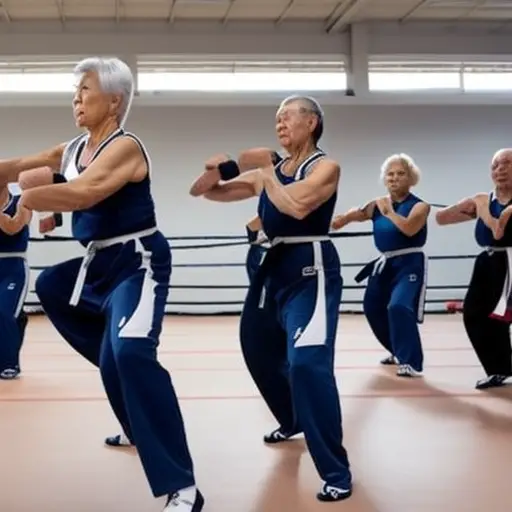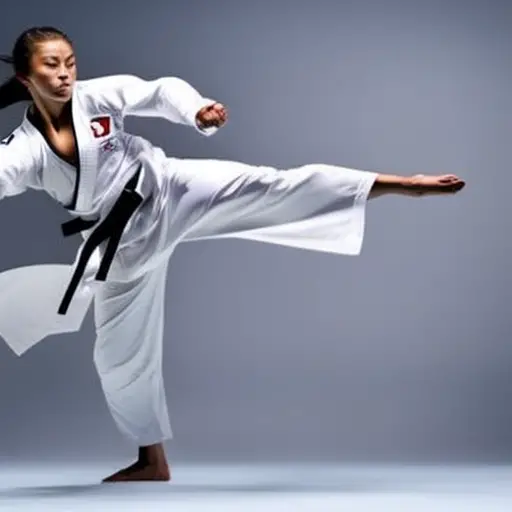The Rise of Taekwondo Programs for Seniors

In recent years, there has been a notable rise in the popularity of taekwondo among seniors, with an increasing number of older adults actively participating in specialized programs tailored to their needs.
This trend is not without reason, as taekwondo has proven to offer numerous benefits for the aging population, promoting physical fitness, mental well-being, and overall healthy aging.
Overcoming barriers to seniors’ involvement, these programs are opening doors to a new era of active and empowered seniors.
The Benefits of Taekwondo for Seniors
While there are numerous benefits of practicing taekwondo for seniors, it is important to highlight the physical and mental advantages that this martial art offers.
Taekwondo is known for its emphasis on kicking and striking techniques, which can greatly contribute to improving mobility in seniors. The various kicks and stances performed in taekwondo help to increase flexibility, balance, and coordination, all of which are essential for maintaining independent movement in older adults. Regular taekwondo training can also help to strengthen muscles and improve cardiovascular fitness, which are crucial for overall physical well-being in seniors.
In addition to the physical benefits, taekwondo can also enhance the mental well-being of seniors. The practice of taekwondo requires focus, discipline, and perseverance, all of which can help to improve cognitive function and mental clarity. The repetitive nature of taekwondo techniques and forms can also have a meditative effect, promoting relaxation and stress reduction. Moreover, the social aspect of taekwondo training provides seniors with opportunities to interact with peers and foster a sense of community, reducing feelings of isolation and loneliness.
Increasing Participation in Taekwondo Among Older Adults
To encourage older adults to participate in taekwondo, program organizers should focus on highlighting the numerous physical and mental benefits that this martial art can offer. Taekwondo is an excellent form of exercise that promotes active aging by improving strength, flexibility, and balance. It can help older adults maintain a healthy weight, reduce the risk of chronic diseases such as heart disease and diabetes, and improve cardiovascular fitness. Additionally, taekwondo can have positive effects on mental well-being by reducing stress levels, improving cognitive function, and boosting self-confidence.
In addition to the physical and mental benefits, taekwondo programs can also provide social engagement for older adults. Participating in taekwondo classes allows seniors to interact with others who share similar interests, fostering a sense of community and belonging. The group setting encourages social interaction and can help combat feelings of loneliness or isolation that some older adults may experience. Engaging in taekwondo together can create a supportive and motivating environment where participants can form friendships and create lasting connections.
Tailoring Taekwondo Programs for the Aging Population
In order to accommodate the unique physical abilities and limitations of older adults, taekwondo programs must be tailored specifically for the aging population. Modified exercises and specialized instructors play a crucial role in ensuring that seniors can participate safely and effectively in taekwondo training.
One key aspect of tailoring taekwondo programs for seniors is modifying the exercises to suit their physical capabilities. As individuals age, they may experience a decline in flexibility, strength, and balance. Therefore, it is important to adjust the intensity and complexity of the exercises to prevent injuries and promote overall fitness. For example, high kicks can be replaced with lower kicks or knee strikes, and jumping or spinning movements can be modified or eliminated.
Specialized instructors who have experience working with older adults are essential in providing appropriate guidance and support. These instructors have a thorough understanding of the aging process and the specific needs of seniors. They can adapt teaching methods to accommodate different learning styles and provide modifications for exercises that may be challenging for older adults. Additionally, they can ensure that proper warm-up and cool-down routines are included to prevent muscle strains or other injuries.
The Role of Taekwondo in Promoting Healthy Aging
Taekwondo serves as both a physical and mental outlet for seniors, contributing to their overall well-being and promoting healthy aging. Engaging in regular taekwondo practice can have a significant impact on preventing age-related diseases and maintaining cognitive function in seniors.
Studies have shown that physical activity, such as taekwondo, can help prevent a range of age-related diseases, including cardiovascular diseases, osteoporosis, and diabetes. Regular exercise improves cardiovascular health, strengthens bones, and helps regulate blood sugar levels, reducing the risk of these conditions. Taekwondo’s emphasis on balance, flexibility, and coordination also helps improve overall physical fitness, reducing the risk of falls and injuries in older adults.
In addition to its physical benefits, taekwondo has been found to have a positive impact on cognitive function in seniors. Research suggests that the combination of physical activity and cognitive engagement in taekwondo can help improve memory, attention, and executive function in older adults. The complex movements and sequences involved in taekwondo training require concentration and mental agility, providing a stimulating environment for the brain.
To further emphasize the role of taekwondo in promoting healthy aging, the following table highlights the specific benefits of taekwondo for seniors:
| Benefits of Taekwondo for Seniors |
|---|
| Prevents age-related diseases |
| Improves cardiovascular health |
| Strengthens bones |
| Reduces the risk of falls |
| Enhances cognitive function |
Overcoming Barriers to Seniors’ Involvement in Taekwondo Programs
Despite the challenges faced by seniors, there are ways to overcome barriers to their involvement in taekwondo programs. It is important to address seniors’ concerns and modify techniques to ensure their safety and comfort. Here are some strategies to help seniors participate in taekwondo programs:
-
Tailor the program: Create classes specifically designed for seniors, taking into account their physical limitations and fitness levels. This will provide a more comfortable and inclusive environment for them to participate in.
-
Provide proper instruction: Ensure that instructors are trained to work with seniors and understand their unique needs. They should be able to modify techniques and exercises to accommodate any physical limitations or health concerns.
-
Encourage social interaction: Foster a supportive and inclusive community within the taekwondo program. This can help seniors feel more comfortable and motivated to participate.
-
Offer flexibility: Provide options for seniors to choose the intensity and duration of their training sessions. This allows them to progress at their own pace and prevents them from feeling overwhelmed or discouraged.
-
Promote the benefits: Highlight the physical, mental, and social benefits of taekwondo for seniors. This can help overcome any initial hesitations or concerns they may have.
Frequently Asked Questions
What Is the History of Taekwondo and How Has It Evolved Over Time?
Taekwondo has a rich history and has evolved over time through the development of new techniques. It has also been found to have a positive impact on mental well-being, providing a practical and evidence-based approach to promoting overall health.
Are There Any Age Restrictions for Participating in Taekwondo Programs for Seniors?
There are no age restrictions for participating in taekwondo programs for seniors. Engaging in taekwondo can provide numerous benefits for older adults, including improved flexibility, balance, and overall physical fitness.
How Can Taekwondo Help Improve Balance and Reduce the Risk of Falls Among Older Adults?
Taekwondo can help improve balance and reduce the risk of falls among older adults through its focus on core strength, flexibility, and coordination. Regular practice of taekwondo techniques can enhance stability and proprioception, leading to better balance control and decreased fall risk.
Are There Any Specific Modifications or Adaptations in Taekwondo Techniques for Seniors With Physical Limitations or Disabilities?
Adaptations in taekwondo techniques for seniors with physical limitations or disabilities involve modifying movements to accommodate reduced flexibility, strength, and balance. These modifications focus on safety, ensuring seniors can participate in taekwondo programs effectively and without risk of injury.
Are There Any Research Studies or Evidence Supporting the Effectiveness of Taekwondo in Promoting Cognitive Health and Memory in Older Adults?
Research studies have shown that taekwondo can have positive effects on cognitive health and memory in older adults. These findings provide evidence for the effectiveness of taekwondo as a means of promoting mental well-being in the elderly population.
Conclusion
In conclusion, the rise of taekwondo programs for seniors highlights the numerous benefits it brings to older adults. By tailoring these programs to meet the specific needs of the aging population, taekwondo promotes healthy aging and helps seniors overcome barriers to participation.
The irony lies in the fact that while many may perceive taekwondo as a sport for the young, it is proving to be a valuable tool for improving the physical and mental well-being of seniors.



